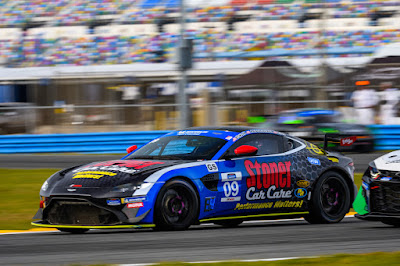An interesting insight from the Stoner Car Care crew ahead of this weekend's IMSA visit to Sebring

Monday, March 14, 2022
The Stoner Car Care Racing fielded by Automatic Racing team heads to one of the world’s legendary racetracks, Sebring International Raceway, this week for the two-hour Alan Jay Automotive Network 120, race two of the 2022 Michelin Pilot Challenge season.
The team also looks forward to contesting a new category within the series’ Grand Sport (GS) Class – the Bronze Cup, which presents individual race podium and season-end recognition to the top FIA Bronze-rated drivers.
The Sebring race week marks the second of two straight “home races” for the Florida-based team, after the season opener in January at Daytona. Rob Ecklin, Jr. and Ramin Abdolvahabi will take the wheel of their iconic No. 09 Stoner Car Care Aston Martin Vantage GT4.
Both Ecklin and Abdolvahabi have raced at Sebring numerous times in several different series, including HSR, the World Racing League and the Michelin Pilot Challenge. But both acknowledge that while every year is different, with different sets of challenges, one thing remains the same: how you manage the infamous Sebring bumps goes a long way toward dictating the outcome of your race“I really like Sebring,” said Ecklin. “Typically, my favorite tracks are ones with elevation changes, but Sebring makes up for a lack of elevation with the abrupt changes in surface, from concrete to asphalt, often in one corner. I’m glad they haven’t changed the track over the years – we’re still competing on the same old bumpy runways that the legends raced in the 50s and 60s. I can’t imagine any other track that can say that. It’s fresh and exciting to run on a newly paved racetrack but to drive on one that’s only been patched for 80 years is so unique.
“To put a lap together over all 17 corners is the name of the game, with a setup that is easy on both car and driver, but that’s easier said than done,” Ecklin continued. “It can also be hard for someone who’s been in winter for months to handle that first blast of heat and humidity of the year!”
Abdolvahabi especially looks forward to his Sebring return, having missed 2021’s edition due to an injury. The Palm Beach Gardens, Fla. neurosurgeon has been racing at Sebring since 2013 and has raced there more than any other track on the IMSA schedule.
“Sebring is one of the hardest tracks in the world to set up for,” said Abdolvahabi. “It throws everything at you from the racetrack checklist: bumps, surface changes, slow corners, fast and sweeping corners with a change of track surface in the middle of the corner, rapidly changing conditions that dramatically affect the racing surface. Some turns are tight, some are wide, some have runoffs, others don’t – and you know it’s going to be warm. It’s such a challenging track. That’s why every team goes there to test. It’s also tough coming right after Daytona on the schedule – Daytona has five turns, basically, while Sebring has 17, and it’s a completely different surface. You can drive Sebring for years and never get bored.
“And Sebring has such a legacy, with its history before it was a racetrack – what it went through, how it was changed. There’s no track like it in the world. You would think that a track like this would have been repaved numerous times over the decades, but teams and drivers are constantly calling on the track to keep the surface the same. That tells you everything you need to know about the history, that after 80 years, no one wants to change it.”
Part of the IMSA WeatherTech SportsCar Championship’s Mobil 1 Twelve Hours of Sebring, the Alan Jay Automotive Network 120 takes the green flag Thursday at 4:25 p.m. Eastern.
Source Material - Stoner Car Care



























